- Home
- Walter Isaacson
The Innovators
The Innovators Read online
HOW A GROUP OF HACKERS, GENIUSES, AND GEEKS CREATED THE DIGITAL REVOLUTION
Thank you for downloading this Simon & Schuster eBook.
* * *
Join our mailing list and get updates on new releases, deals, bonus content and other great books from Simon & Schuster.
CLICK HERE TO SIGN UP
or visit us online to sign up at
eBookNews.SimonandSchuster.com
CONTENTS
Illustrated Timeline
Introduction
CHAPTER 1
Ada, Countess of Lovelace
CHAPTER 2
The Computer
CHAPTER 3
Programming
CHAPTER 4
The Transistor
CHAPTER 5
The Microchip
CHAPTER 6
Video Games
CHAPTER 7
The Internet
CHAPTER 8
The Personal Computer
CHAPTER 9
Software
CHAPTER 10
Online
CHAPTER 11
The Web
CHAPTER 12
Ada Forever
Acknowledgments
About the Author
Notes
Photo Credits
Index
1843
Ada, Countess of Lovelace, publishes “Notes” on Babbage’s Analytical Engine.
1847
George Boole creates a system using algebra for logical reasoning.
1890
The census is tabulated with Herman Hollerith’s punch-card machines.
1931
Vannevar Bush devises the Differential Analyzer, an analog electromechanical computer.
1935
Tommy Flowers pioneers use of vacuum tubes as on-off switches in circuits.
1937
Alan Turing publishes “On Computable Numbers,” describing a universal computer.
Claude Shannon describes how circuits of switches can perform tasks of Boolean algebra.
Bell Labs’ George Stibitz proposes a calculator using an electric circuit.
Howard Aiken proposes construction of large digital computer and discovers parts of Babbage’s Difference Engine at Harvard.
John Vincent Atanasoff puts together concepts for an electronic computer during a long December night’s drive.
1938
William Hewlett and David Packard form company in Palo Alto garage.
1939
Atanasoff finishes model of electronic computer with mechanical storage drums.
Turing arrives at Bletchley Park to work on breaking German codes.
1941
Konrad Zuse completes Z3, a fully functional electromechanical programmable digital computer.
John Mauchly visits Atanasoff in Iowa, sees computer demonstrated.
1942
Atanasoff completes partly working computer with three hundred vacuum tubes, leaves for Navy.
1943
Colossus, a vacuum-tube computer to break German codes, is completed at Bletchley Park.
1944
Harvard Mark I goes into operation.
John von Neumann goes to Penn to work on ENIAC.
1945
Von Neumann writes “First Draft of a Report on the EDVAC” describing a stored-program computer.
Six women programmers of ENIAC are sent to Aberdeen for training.
Vannevar Bush publishes “As We May Think,” describing personal computer.
Bush publishes “Science, the Endless Frontier,” proposing government funding of academic and industrial research.
ENIAC is fully operational.
1947
Transistor invented at Bell Labs.
1950
Turing publishes article describing a test for artificial intelligence.
1952
Grace Hopper develops first computer compiler.
Von Neumann completes modern computer at the Institute for Advanced Study.
UNIVAC predicts Eisenhower election victory.
1954
Turing commits suicide.
Texas Instruments introduces silicon transistor and helps launch Regency radio.
1956
Shockley Semiconductor founded.
First artificial intelligence conference.
1957
Robert Noyce, Gordon Moore, and others form Fairchild Semiconductor.
Russia launches Sputnik.
1958
Advanced Research Projects Agency (ARPA) announced.
Jack Kilby demonstrates integrated circuit, or microchip.
1959
Noyce and Fairchild colleagues independently invent microchip.
1960
J. C. R. Licklider publishes “Man-Computer Symbiosis.”
Paul Baran at RAND devises packet switching.
1961
President Kennedy proposes sending man to the moon.
1962
MIT hackers create Spacewar game.
Licklider becomes founding director of ARPA’s Information Processing Techniques Office.
Doug Engelbart publishes “Augmenting Human Intellect.”
1963
Licklider proposes an “Intergalactic Computer Network.”
Engelbart and Bill English invent the mouse.
1964
Ken Kesey and the Merry Pranksters take bus trip across America.
1965
Ted Nelson publishes first article about “hypertext.”
Moore’s Law predicts microchips will double in power each year or so.
1966
Stewart Brand hosts Trips Festival with Ken Kesey.
Bob Taylor convinces ARPA chief Charles Herzfeld to fund ARPANET.
Donald Davies coins the term packet switching.
1967
ARPANET design discussions in Ann Arbor and Gatlinburg.
1968
Larry Roberts sends out request for bids to build the ARPANET’s IMPs.
Noyce and Moore form Intel, hire Andy Grove.
Brand publishes first Whole Earth Catalog.
Engelbart stages the Mother of All Demos with Brand’s help.
1969
First nodes of ARPANET installed.
1971
Don Hoefler begins column for Electronic News called “Silicon Valley USA.”
Demise party for Whole Earth Catalog.
Intel 4004 microprocessor unveiled.
Ray Tomlinson invents email.
1972
Nolan Bushnell creates Pong at Atari with Al Alcorn.
1973
Alan Kay helps to create the Alto at Xerox PARC.
Ethernet developed by Bob Metcalfe at Xerox PARC.
Community Memory shared terminal set up at Leopold’s Records, Berkeley.
Vint Cerf and Bob Kahn complete TCP/IP protocols for the Internet.
1974
Intel 8080 comes out.
1975
Altair personal computer from MITS appears.
Paul Allen and Bill Gates write BASIC for Altair, form Microsoft.
First meeting of Homebrew Computer Club.
Steve Jobs and Steve Wozniak launch the Apple I.
1977
The Apple II is released.
1978
First Internet Bulletin Board System.
1979
Usenet newsgroups invented.
Jobs visits Xerox PARC.
1980
IBM commissions Microsoft to develop an operating system for PC.
1981
Hayes modem marketed to home users.
1983
Microsoft announces Windows.
Richard Stallman begins developing GNU, a free operating system.
1984
Apple introduces Macintosh.
1985
Stewart Brand and Larry Brilliant launch The WELL.
CVC launches Q-Link, which becomes AOL.
1991
Linus Torvalds releases first version of Linux kernel.
Tim Berners-Lee announces World Wide Web.
1993
Marc Andreessen announces Mosaic browser.
Steve Case’s AOL offers direct access to the Internet.
1994
Justin Hall launches Web log and directory.
HotWired and Time Inc.’s Pathfinder become first major magazine publishers on Web.
1995
Ward Cunningham’s Wiki Wiki Web goes online.
1997
IBM’s Deep Blue beats Garry Kasparov in chess.
1998
Larry Page and Sergey Brin launch Google.
1999
Ev Williams launches Blogger.
2001
Jimmy Wales, with Larry Sanger, launches Wikipedia.
2011
IBM’s computer Watson wins Jeopardy!
INTRODUCTION
* * *
HOW THIS BOOK CAME TO BE
The computer and the Internet are among the most important inventions of our era, but few people know who created them. They were not conjured up in a garret or garage by solo inventors suitable to be singled out on magazine covers or put into a pantheon with Edison, Bell, and Morse. Instead, most of the innovations of the digital age were done collaboratively. There were a lot of fascinating people involved, some ingenious and a few even geniuses. This is the story of these pioneers, hackers, inventors, and entrepreneurs—who they were, how their minds worked, and what made them so creative. It’s also a narrative of how they collaborated and why their ability to work as teams made them even more creative.
The tale of their teamwork is important because we don’t often focus on how central that skill is to innovation. There are thousands of books celebrating people we biographers portray, or mythologize, as lone inventors. I’ve produced a few myself. Search the phrase “the man who invented” on Amazon and you get 1,860 book results. But we have far fewer tales of collaborative creativity, which is actually more important in understanding how today’s technology revolution was fashioned. It can also be more interesting.
We talk so much about innovation these days that it has become a buzzword, drained of clear meaning. So in this book I set out to report on how innovation actually happens in the real world. How did the most imaginative innovators of our time turn disruptive ideas into realities? I focus on a dozen or so of the most significant breakthroughs of the digital age and the people who made them. What ingredients produced their creative leaps? What skills proved most useful? How did they lead and collaborate? Why did some succeed and others fail?
I also explore the social and cultural forces that provide the atmosphere for innovation. For the birth of the digital age, this included a research ecosystem that was nurtured by government spending and managed by a military-industrial-academic collaboration. Intersecting with that was a loose alliance of community organizers, communal-minded hippies, do-it-yourself hobbyists, and homebrew hackers, most of whom were suspicious of centralized authority.
Histories can be written with a different emphasis on any of these factors. An example is the invention of the Harvard/IBM Mark I, the first big electromechanical computer. One of its programmers, Grace Hopper, wrote a history that focused on its primary creator, Howard Aiken. IBM countered with a history that featured its teams of faceless engineers who contributed the incremental innovations, from counters to card feeders, that went into the machine.
Likewise, what emphasis should be put on great individuals versus on cultural currents has long been a matter of dispute; in the mid-nineteenth century, Thomas Carlyle declared that “the history of the world is but the biography of great men,” and Herbert Spencer responded with a theory that emphasized the role of societal forces. Academics and participants often view this balance differently. “As a professor, I tended to think of history as run by impersonal forces,” Henry Kissinger told reporters during one of his Middle East shuttle missions in the 1970s. “But when you see it in practice, you see the difference personalities make.”1 When it comes to digital-age innovation, as with Middle East peacemaking, a variety of personal and cultural forces all come into play, and in this book I sought to weave them together.
* * *
The Internet was originally built to facilitate collaboration. By contrast, personal computers, especially those meant to be used at home, were devised as tools for individual creativity. For more than a decade, beginning in the early 1970s, the development of networks and that of home computers proceeded separately from one another. They finally began coming together in the late 1980s with the advent of modems, online services, and the Web. Just as combining the steam engine with ingenious machinery drove the Industrial Revolution, the combination of the computer and distributed networks led to a digital revolution that allowed anyone to create, disseminate, and access any information anywhere.
Historians of science are sometimes wary about calling periods of great change revolutions, because they prefer to view progress as evolutionary. “There was no such thing as the Scientific Revolution, and this is a book about it,” is the wry opening sentence of the Harvard professor Steven Shapin’s book on that period. One method that Shapin used to escape his half-joking contradiction is to note how the key players of the period “vigorously expressed the view” that they were part of a revolution. “Our sense of radical change afoot comes substantially from them.”2
Likewise, most of us today share a sense that the digital advances of the past half century are transforming, perhaps even revolutionizing the way we live. I can recall the excitement that each new breakthrough engendered. My father and uncles were electrical engineers, and like many of the characters in this book I grew up with a basement workshop that had circuit boards to be soldered, radios to be opened, tubes to be tested, and boxes of transistors and resistors to be sorted and deployed. As an electronics geek who loved Heathkits and ham radios (WA5JTP), I can remember when vacuum tubes gave way to transistors. At college I learned programming using punch cards and recall when the agony of batch processing was replaced by the ecstasy of hands-on interaction. In the 1980s I thrilled to the static and screech that modems made when they opened for you the weirdly magical realm of online services and bulletin boards, and in the early 1990s I helped to run a digital division at Time and Time Warner that launched new Web and broadband Internet services. As Wordsworth said of the enthusiasts who were present at the beginning of the French Revolution, “Bliss was it in that dawn to be alive.”
I began work on this book more than a decade ago. It grew out of my fascination with the digital-age advances I had witnessed and also from my biography of Benjamin Franklin, who was an innovator, inventor, publisher, postal service pioneer, and all-around information networker and entrepreneur. I wanted to step away from doing biographies, which tend to emphasize the role of singular individuals, and once again do a book like The Wise Men, which I had coauthored with a colleague about the creative teamwork of six friends who shaped America’s cold war policies. My initial plan was to focus on the teams that invented the Internet. But when I interviewed Bill Gates, he convinced me that the simultaneous emergence of the Internet and the personal computer made for a richer tale. I put this book on hold early in 2009, when I began working on a biography of Steve Jobs. But his story reinforced my interest in how the development of the Internet and computers intertwined, so as soon as I finished that book, I went back to work on this tale of digital-age innovators.
* * *
The protocols of the Internet were devised by peer collaboration, and the resulting system seemed to have embedded in its genetic code a propensity to facilitate such collaboration. The power to create and transmit information was fully distributed to eac
h of the nodes, and any attempt to impose controls or a hierarchy could be routed around. Without falling into the teleological fallacy of ascribing intentions or a personality to technology, it’s fair to say that a system of open networks connected to individually controlled computers tended, as the printing press did, to wrest control over the distribution of information from gatekeepers, central authorities, and institutions that employed scriveners and scribes. It became easier for ordinary folks to create and share content.

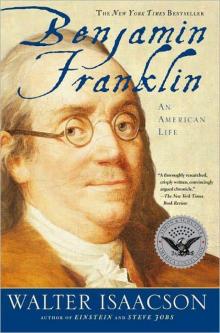 Benjamin Franklin: An American Life
Benjamin Franklin: An American Life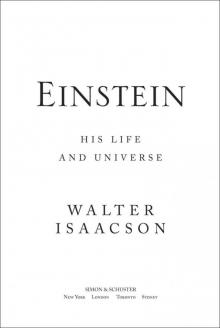 Einstein: His Life and Universe
Einstein: His Life and Universe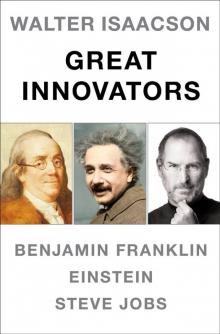 Walter Isaacson Great Innovators e-book boxed set
Walter Isaacson Great Innovators e-book boxed set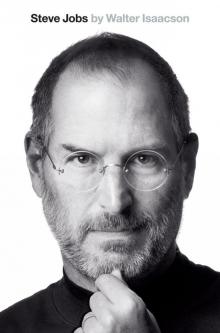 Steve Jobs
Steve Jobs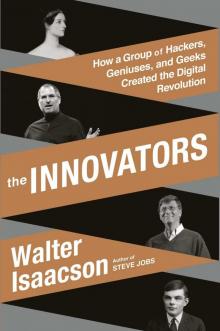 The Innovators
The Innovators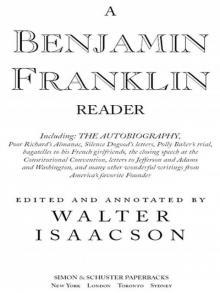 A Benjamin Franklin Reader
A Benjamin Franklin Reader